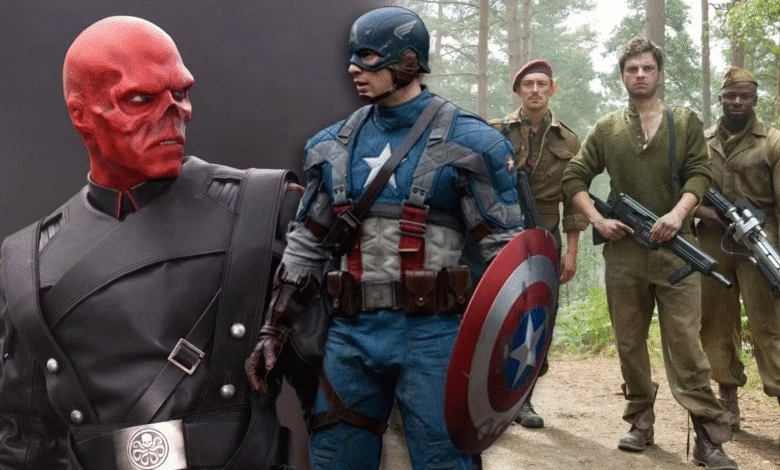Captain America: The First Avenger (2011) – A Bold Step into the Marvel Universe

Marvel Studios took a bold leap into World War II-era storytelling with Captain America: The First Avenger in 2011. As the fifth installment in the Marvel Cinematic Universe (MCU), this film not only laid the groundwork for the Avengers saga but also provided a deeper historical context to the superhero genre. Starring Chris Evans as the iconic Steve Rogers, the movie introduces audiences to the birth of Captain America, the rise of HYDRA, and the chilling antagonist Johann Schmidt, better known as Red Skull. The antagonist’s terrifying transformation and militarized appearance are encapsulated in the Red Skull Costume, a symbol of twisted power and scientific horror.
A Look Back in Time: The Setting
“Captain America: The First Avenger” stands out for its unique period setting, transporting viewers to the early 1940s during World War II. Unlike most modern superhero films that revolve around advanced technology or futuristic cities, this movie finds its strength in nostalgia, patriotism, and vintage military aesthetics. From the sepia-toned streets of Brooklyn to the snow-covered HYDRA bases in the Alps, the film recreates an era where the fate of the world was determined by both science and sacrifice.
The film uses a blend of practical sets, costume design, and CGI to immerse audiences in the wartime narrative. Whether it’s the retro vehicles, wartime propaganda posters, or old-school uniforms, every visual detail helps reinforce the sense of time and place.
Steve Rogers: From Underdog to Super-Soldier
At the heart of the movie is Steve Rogers, a frail but determined young man who dreams of joining the military and serving his country. What makes Rogers a compelling protagonist is not his strength—because he starts with none—but his unshakeable moral compass. He’s brave, selfless, and persistent. These qualities make him the ideal candidate for Dr. Erskine’s Super Soldier experiment.
Through groundbreaking visual effects, the film convincingly portrays Chris Evans as a 90-pound weakling before he transforms into the buff, shield-wielding superhero we all recognize. This metamorphosis isn’t just physical—it’s symbolic. Rogers evolves into a leader who inspires troops and civilians alike, proving that strength of character matters more than muscle.
The Origins of HYDRA and Red Skull
Every great hero needs a formidable villain, and Red Skull delivers on that front. Played chillingly by Hugo Weaving, Johann Schmidt is the embodiment of Nazi fanaticism and unhinged scientific ambition. As the head of HYDRA, a rogue Nazi science division, Schmidt seeks to use the power of the Tesseract—a mysterious cosmic cube—to reshape the world according to his vision.
Schmidt’s descent into madness, culminating in his transformation into the grotesque Red Skull, is a powerful narrative arc. Unlike other villains who are driven by revenge or greed, Red Skull views himself as a superior being destined to rule. His costume, with its black leather and militaristic design, signals his departure from humanity and aligns him with a darker, more alien form of power.
Peggy Carter and the Strong Female Lead
Another standout element in the film is the portrayal of Agent Peggy Carter, played by Hayley Atwell. Far from being just a love interest, Peggy is a capable officer with intelligence, confidence, and grit. She commands respect from her peers and isn’t afraid to challenge the male-dominated military structure of the time.
The chemistry between Peggy and Steve is authentic and emotionally resonant. Their relationship, built on mutual admiration and respect, adds depth to the story. It also sets the stage for some of the most emotional moments in the MCU, particularly Steve’s final radio message before crashing into the Arctic.
The Howling Commandos and Team Dynamics
Captain America doesn’t fight HYDRA alone. Once he earns his stripes, Steve assembles a team of elite soldiers known as the Howling Commandos. This ragtag group brings energy and diversity to the film, with characters like Dum Dum Dugan and Gabe Jones adding color to the battle scenes.
Their mission-based assaults on HYDRA installations give the movie a dynamic, almost Indiana Jones-like adventure feel. These sequences balance action with humor and camaraderie, highlighting the importance of teamwork even in the darkest of times.
The Symbolism of the Shield
Captain America’s shield is more than just a weapon; it’s a representation of his ideals. Made from vibranium, the shield becomes a signature tool of defense and attack. What makes it even more interesting is how the film uses the shield symbolically. When Steve uses it to protect others, it reflects his core value: to stand up for the vulnerable.
Throughout the movie, the shield evolves along with Steve’s identity. From a stage prop in propaganda films to a battle-tested weapon, the shield becomes a tangible link between the man and the myth.
Visual Effects and Practical Designs
The movie blends practical effects and CGI with finesse. The de-aging and body-shrinking effect used to portray pre-serum Steve Rogers was revolutionary for its time. Additionally, the visual style remains grounded despite the sci-fi elements. The design of the HYDRA weapons and vehicles borrows from actual WWII prototypes, lending authenticity to the tech without straying too far into fantasy.
The action sequences, including train ambushes and motorcycle chases, are choreographed with clarity and energy. Rather than overwhelming the viewer with explosions, the film focuses on strategic combat and clear storytelling.
The Final Act and Steve’s Sacrifice
The climax of the film is both thrilling and heartbreaking. As Captain America battles Red Skull aboard a high-tech bomber filled with Tesseract-powered weapons, he ultimately makes the ultimate sacrifice. Rather than risk mass destruction, he crashes the plane into the Arctic, knowing he may not survive.
This act defines who Steve Rogers is—a man who would rather lose everything than let evil win. His goodbye to Peggy, filled with unspoken words and tragic timing, leaves a lasting emotional impact that reverberates through future Marvel films.
Legacy and Connection to the MCU
“Captain America: The First Avenger” successfully bridges the gap between a historical war drama and a superhero origin story. It serves as a prelude to the larger Avengers storyline while standing strong as a solo film. The post-credit scene, featuring Nick Fury and a teaser for “The Avengers,” signals a new chapter in the Marvel saga.
Beyond box office success, the film earned praise for its sincere storytelling, character-driven plot, and thematic depth. It showed that superhero films could be emotionally resonant while still delivering blockbuster thrills.
Final Thoughts
“Captain America: The First Avenger” remains one of the MCU’s most heartfelt and heroic entries. By grounding the film in history and focusing on character development, it avoided many of the clichés of early superhero cinema. From its stirring performances to its memorable villain and iconic shield, it set the stage for what was to come. And whether you were captivated by the war setting, HYDRA’s menace, or the transformation of a hero, one thing is certain—this film gave us a timeless legacy. The timeless appeal also continues through its costume-inspired merchandise, including the widely admired Captain America Costume, which remains a fan favorite among cosplay and fashion enthusiasts.




